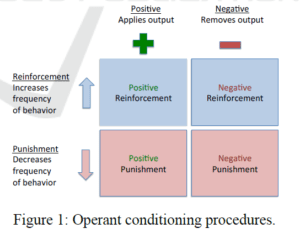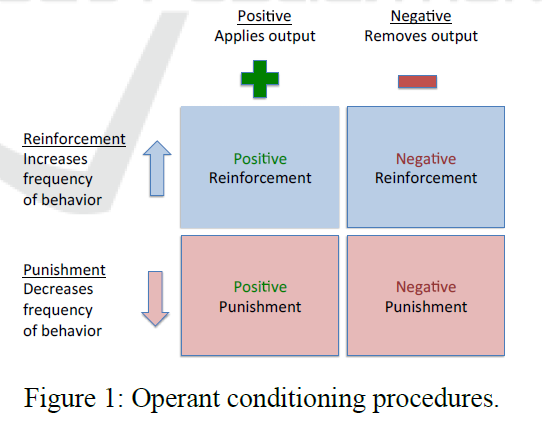Companion Gun-Dog
Lesson 1: Theory, Terminology, and Philosophy
Terms:
Behaviorism – Theory of learning which states all behaviors are learned through interactions with the environment via a process known as conditioning. “Behavior is simply a response to environmental stimuli.”
Classical Conditioning – (Pavlovian or respondent conditioning) Two stimuli are linked together to create a new learned response. Also known as associative learning.
-Unconditioned stimulus (UCS)
– Before conditioning an unconditioned stimulus produces and unconditioned response (UCR). Food > Salivation
-Neutral stimulus (NS)
– Before conditioning a neutral stimulus has no effect on the subject. Tone > No response
-Conditioned stimulus (CS)
– When paired with with the UCS the NS will become the CS
– After conditioning, the CS will now have the power to elicit the response that was associated with the UCS
-Pavlov’s experiment
– UCS = Food
– Response = Salivation
– NS = Door tone
– NS + UCS over time = CS
– Importance of reflexive response
– It is important to note that classically conditioned responses are reflexive in nature. The subject does not consciously choose to salivate.
Operant Conditioning – Learning theory normally attributed to B.F. Skinner where the consequences of a response determine the probability it being repeated. Built upon Thorndike’s law of effect. Operant conditioning describes how organisms interact with their environment (Organism acts, environment reacts to organism’s action).
– Operant
– Response from the environment
– Reinforcer
– Response from the environment that increases the probability of the behavior being repeated.
– Punisher
– Response from the environment that decreases the probability of the behavior being repeated.
– Positive
– Addition of reinforcing or punishing stimuli
– Negative
– Removal of reinforcing or punishing stimuli
– Graphic representation of The Operant Model

– Schedules of Reinforcement
– Different patterns (schedules) of reinforcement have different effects on the speed of learning and extinction.
– Response Rate
-The rate at which the subject acts upon the environment to receive reinforcement.
– Extinction Rate
– The rate at which the action dies out (how quickly the subject gives up).
-Interval
-The time between reinforcements
-Ratio
-The number of responses between reinforcements
-Continuous Reinforcement
-Response rate is slow
-Extinction rate is fast
-Fixed Ratio Reinforcement
-Response rate fast
-Extinction rate medium
–Fixed Interval Reinforcement
-Response rate is medium
-Extinction rate is medium
–Variable Ratio Reinforcement
-Response rate is fast
-Extinction rate is slow
–Variable Interval Reinforcement
-Response rate is fast
-Extinction rate is slow
McLeod, S. A. (2018, January, 21). Skinner – operant conditioning. Simply Psychology. https://www.simplypsychology.org/operant-conditioning.html
Drive – Drive theory is based on the principle that organisms are born with certain psychological needs and that a negative state of tension is created when these needs are not satisfied. When a need is satisfied, drive is reduced and the organism returns to a state of homeostasis and relaxation.
Important figures in chronological order:
Ivan Pavlov – Physiologist that published the results of his famous experiment regarding conditioning after originally studying digestion in dogs. (1897)
Edward Thorndike – Introduced the concept of reinforcement and put forward the “Law of effect” which stated that behaviors followed by pleasant consequences are likely to be repeated and behaviors followed by unpleasant consequences are likely to be stopped. (1905)
John Watson – Father of behaviorism. Published first work on the subject in 1913. Believed that all organisms were born a blank slate (Methodological Behaviorism). Published results of “Little Albert” experiment with Raynor in 1920.
BF Skinner – Wrote the Behavior of Organisms in 1936. Introduced the concepts of operant conditioning and shaping. Published Walden Two in 1948 about a utopian society founded on behavioral principles. Considered the first (Radical Behaviorist) by breaking with Watson over the belief that organisms did not start as “blank slates” but were born with certain instinctive behaviors.
Clark Hull – Publishes Principles of Behavior in 1943, in it he explains his “drive reduction theory of motivation”
McLeod, S. A. (2017, Febuary 05). Behaviorist approach. Simply Psychology. https://www.simplypsychology.org/behaviorism.html
Companion Gundog Philosophy:
General:
“As to methods, there may be a million and then some, but principles are few. The man who grasps principles can successfully select his own methods. The man who tries methods, ignoring principles, is sure to have trouble.” – Harrington Emerson
“It is important to view knowledge as sort of a semantic tree—make sure you understand the fundamental principles, i.e. the trunk and big branches, before you get into the leaves/details or there is nothing for them to hang on to.” – Elon Musk
“Learn the rules like a pro, so you can break them like an artist” – Pablo Picasso
Develop an understanding of the principles and use it as a lens though which you view the methods that make up various traditions of dog training. Dissect these methods and retain what you believe to be valuable and discard what you believe to be of no value. Take this information and practice freedom of expression as the best dog trainer you can be.
Balanced Training:
- Results oriented
- Use appropriate framework (methods/systems) and tools based on age/maturity/competence
- Frameworks
- Reward based systems
- Food and prey rewards
- Lure and reward
- Free shaping
- Marker systems
- Tools
- Compulsive systems (Escape/Avoidance)
- Leash manipulation
- E-Collar conditioning
- Tools
- Reward based systems
- Frameworks
Phases of Training:
-Acquisition
-Fluency
-Generalization
-Maintenance



